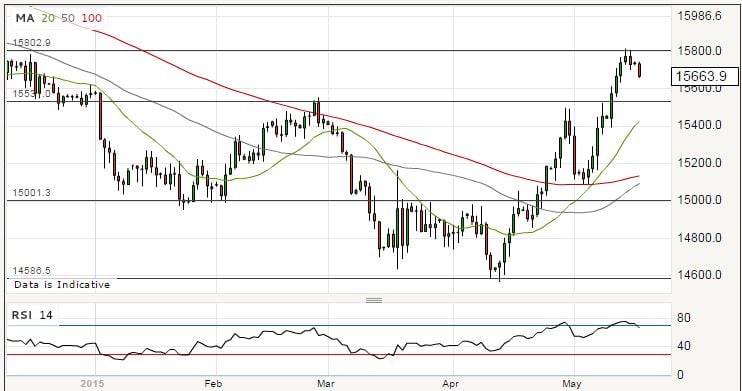GBP/USD Exchange Rate Losses Arrested, 1.55 Support Key

The UK currency appears to have hit its limit against the dollar for the time being, however forecasts from a number of leading industry names confirm the month ahead could well yield further gains in GBP-USD.
The British pound achieved its best rate of exchange against the US dollar in mid-May. The GBP-USD has since slumped to 1.5504 following the release of inflation data that confirms the UK economy has entered a period of deflation. On a year-on-year basis inflation read at -0.1%, markets had priced sterling for a reading of 0% and the disappointment confirms the Bank of England may consider delaying an interest rate rise in order to keep inflation stable.
Despite the decline it is too early to set aside analyst forecasts that suggest the GBP remains favoured to re-test the levels at 1.58 against the USD.
The USD, in the most part, remains in a downward correction phase from the highs set against all major currencies earlier in the year. From a technical angle, we are however reaching important areas of support for the broader USD basket which suggests any further losses could be limited in nature - if this were to be correct those hoping for a stronger GBP-USD will be disappointed.
Nevertheless, there is little from the fundamental data to confirm a return to a new period of strength for America's currency. “It’s a simple point, but an important one. With deflationary risks subsiding outside the US and less aggressive easing globally, a USD revival needs a pickup in US economic activity,” points out the latest forecast note from Morgan Stanley.
“With the market more balanced, poor US data should have less aggressive downside impact, while positive data should see more of an upside reaction than recently experienced,” those hoping for a higher GBP-USD exchange rate are warned by Lloyds Bank Research in a morning forecast note to clients.
Forecasts for the Pound v Dollar
As we can see from the below, the rally higher in GBP-USD appears to have stalled just below 1.58 which would suggest that gains could become harder to come by. Nevertheless, the trend higher remains valid with a host of momentum indicators advocating for more gains over coming weeks. As we noted here, we could see another month of USD weakness, something that would afford the pound sterling the chance to rally.
Beware. All quotes in this article reference the inter-bank spot rate. Your bank transfer will affix a spread at discretion. Independent providers are however able to get you closer to the spot market rate, in some cases this can deliver up to 5% more currency. Find out more.
Arnaud Masset, Market Strategist at Swissquote Bank says the prospect for an exchange rate of 1.5879 remains possible, but patience may be required:
“GBP/USD breathes after a 7-day rally, consolidating between 1.57-1.58. The cable validated the break of the 38.2% Fibonacci level (on July 2014 – April 2015 sell-off) and the 200dma; the pair will need some fresh boost to clear the next resistance standing at 1.5879.”
GBP/USD consolidates around 1.55 after the sharp sell-off witnessed in London following the inflation release. "The sterling did not validate the break of the strong 1.55 support. Once it’ll be done, the road will be wide open to 1.54, then 1.52," warns Masset.
No Fundamental Justification for a Return to USD Strength
The GBP has been allowed to advance against the USD as economic data releases coming out of the United States continue to disappoint. There is a general underlying assumption that the data will improve over mid-year as the impact of seasonal factors are left behind.
Nevertheless, the current soft patch could run further and keep the dollar under pressure against the pound sterling say analysts at Barclays.
“Although there are indications that the underlying trend in the US economy remains intact, the market has had to weigh this against the mixed tone of the recent data. The string of weak retail sales prints has been increasingly at odds with the Fed’s view that lower oil prices will boost consumption and inflation down the road,” says a client research note from Barclays.
USD strength was reignited yesterday on the back of the San Francisco Fed’s optimism on US growth. Despite this, Goldman Sachs strategists in a mid-week brief to clients, warn that it still remains to be seen whether this is just a move lower in a range or if we are resuming a downward trend. "For the time being we remain cautious and maintain a neutral stance with minimum positioning, looking to be flexible intraday," say Goldman.
The USD is forecast to likely to remain under pressure over the coming week, driven by the bearish tone to data releases.
United States headline and core inflation numbers appear to have bottomed, however point out Barclays. Consumer prices (Friday) will provide evidence whether is indeed the case. Barclays expect a bigger pullback in headline CPI than the consensus, to -0.3% y/y from -0.1% y/y, but are at consensus for the fall in core CPI to 1.7% y/y.
Other key data during the week include housing starts (Tuesday), existing home sales, and the Philly Fed (Thursday). Barclays expect slightly weaker outturns than the market consensus and the housing market data to show improvements.
Furthermore, the British bank expects housing starts for April to rise to 982k from 926k, but below consensus forecasts of 1020k.

